SITREP 5/24/24: Situation Turns Critical as De-legitimized Zelensky Dangerously Escalates
Let’s get right into the most pressing development: a narrative overload has swelled around the topic of allowing Ukrainian strikes on Russian soil. It has suddenly become the top coordinated focus for the entire deepstate establishment, with Zelensky and complicit Congressmembers forming a critical mass of pressure against the Biden administration, with some claiming they’re gaining headway.
You have to really read between the lines to understand the hidden layers of what’s going on: such heavily coordinated campaigns are never spontaneous but almost always part of a deeply thought out strategic shift to veer the war in a new direction.
The reason is obvious: Ukraine is at a crossroads and a potential breaking point. The political situation has hit rock bottom, with Zelensky’s authority and legitimacy quickly unspooling; the manpower issue is reportedly very bad and is not being addressed by the newly announced mobilization; and on top of all that, Russia appears on the brink of opening up another in a series of new fronts that could bring the AFU to the brink by stretching the lines like never before.
Here’s where the ominous signs begin.
There are increasing signals that the covert plan from the globalist controllers is to get Ukraine to leave Russia with no choice but to escalate drastically and bring NATO in some form, whether limited or not, into the fight. Ex-British MP Andrew Bridgen stated that this is the real reason why Rishi Sunak has called an early election—he refuses to be a ‘war time president’.
Listen to the chilling details below:
This comes on the heels of articles like the following which reveals that British special operation forces have already been operating on the frontline in Ukraine, in greater capacities than we think:
Though not exactly a sterling source anymore, just to dress the scene, Rybar likewise claimed that Taurus missiles are already in Ukraine:
“Taurus missiles are already in Ukraine, their combat use is a matter of time. Berlin is just waiting for instructions to announce this,” said the author of the expert analytical project “Rybar”, assessing the statements of the British Minister of Defense.
Previously, military experts reported that deliveries of weapons (including ATACMS and Storm Shadow | Scalp missiles) are always carried out before talk of “quick deliveries” begins. Also, a colossal scandal was caused by the leak of negotiations between the Bundeswehr leadership about the launch of “dozens of Taurus across the Crimean Bridge by the hands of NATO military.”
In addition, Western military analysts noted that Taurus missiles will be able to fly from the Sumy region of Ukraine to the capital of Russia - Moscow and other cities, factories, etc.
In accordance with the script given him, Gary Kasparov also declared his encouragement for Ukraine to begin striking large Russian cities like Moscow and St. Petersburg with the new weaponry:
Stoltenberg and a host of other apparatchiks followed suit in the highly coordinated push:
As quick reminder, Russian General Evgeny Buzhinky stated the following a month or so ago:
“I do not have firm information about how the Russian president and Russian military command will act, but I am sure that if the strikes of Taurus of ATACMS are very harmful for Russia, then I presume we will at least strike the logistical hub in the territory of Poland in Rzeszów. In this case, it will be up to the United States to decide what to do. Either to go to the Third World War with mutual destruction or leave the Poles to fight Russia alone,” retired Russian Lieutenant General Evgeny Buzhinsky, told the New Rules podcast.
You might be thinking this is all just speculative hearsay and threadpulling thus far. But Russia has clearly read the tea leaves and signaled in kind, as the defense ministry announced they would be conducting an unprecedented series of tactical nuclear exercises. This would revolve around finetuning the launch of tactical combat nukes, rather than strategic ones that fly across the ocean. The message here is simple and clear: Russia is issuing the response that if things continue escalating in the current dangerous direction then Russia may have no choice but to bring much more devastating weaponry to bear.
A video of one of the exercises was released, showcasing a tactical nuclear Iskander being readied, which you can see is even uncommonly blurred out to hide its unique nuclear-capable warhead:
Western commentators began to note the never-before-seen differences in this nuclear variant of the Iskander K and M variants:
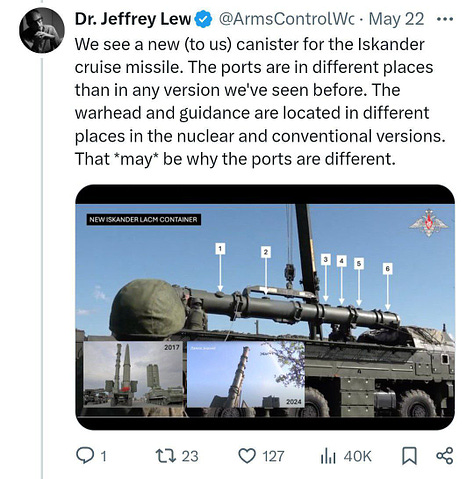
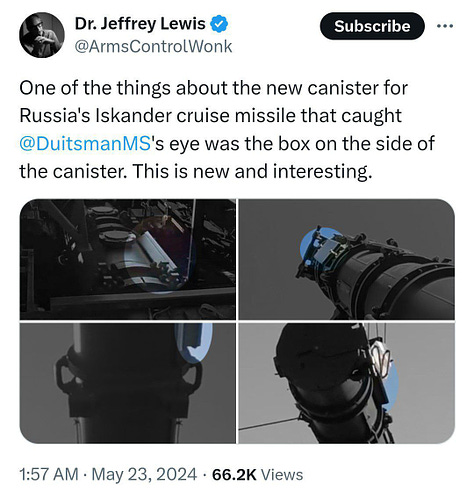
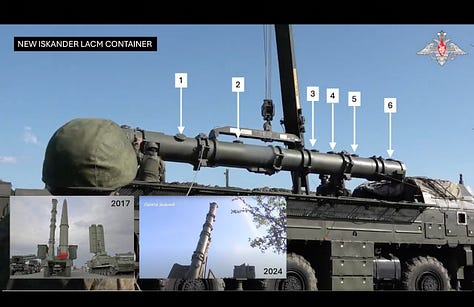
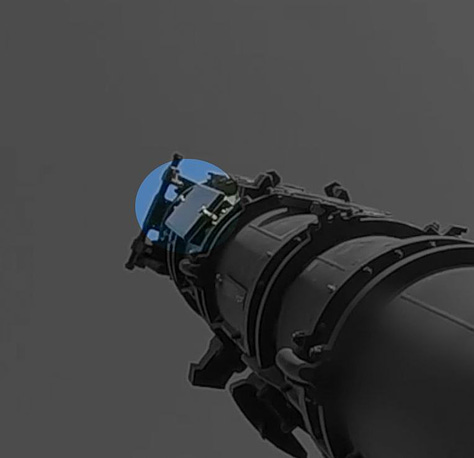
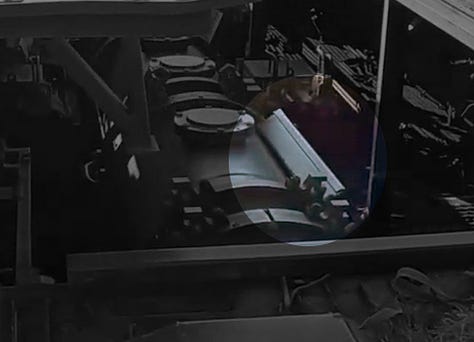
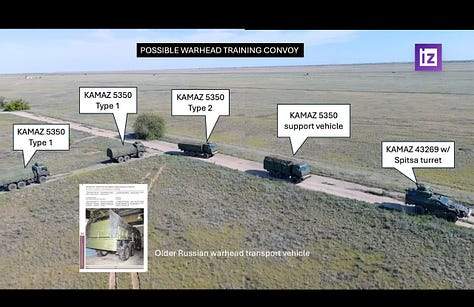
“Zelensky wants a conflict between the United States and Russia to begin,” American television The Hill.
But why should Russia suddenly worry about this? Ukraine has been attempting to strike Russian targets for a while now without much success. Well, because now Ukraine is having serious success. I previously reported on the Russian S-400’s troubles against the ATACMS missile: the problems have gotten much worse for Russia. S-400s are now being regularly taken out to pasture by the barely stoppable ATACMS.
Another battery was just decimated yesterday in Donetsk with a second claimed one being hit in Alushta, Crimea again, though there’s no definitive evidence on that yet. Though I should note I’m not sure it’s proven the below is an S-400, as some suggest it could have been an S-300/350 series based on the destroyed radar.
But here we can finally see in full color how it goes down with the newly released Ukrainian footage. Not only is the S-300/400 and surrounding Shorad defenders—if any—incapable of neutralizing the guiding Shark drone, but the ATACMS missiles themselves overwhelm the battery:
How do we know it’s ATACMS and not anything else? The extremely wide cluster munitions spread is consistent with the much larger ATACMS rather than HIMARS, for instance, which carries less munitions and has a far smaller spread. Also, in the post-strike damage video seen above you can clearly see a discarded ATACMS fuselage on the ground. Ukraine also released a video showing a launch of up to 8 or more ATACMS, though it’s not 100% clear it is meant to show this one specific attack, though that appeared to be the implication.
So: assuming that launch was in fact connected to this particular S-400 hit, what can we surmise? The S-400 battery clearly launches a slew of missiles, and most analysts are interpreting that to mean that the battery did manage to shoot down almost the entire ATACMS package, with only one missile hitting cleanly at the end. But that one was enough to destroy virtually the entire battery.
The problem is: the S-400 is meant to have a 400km detection range. But the system is clearly engaging the ATACMS only seconds away from their impact. This could indicate a major shortcoming of the system, or merely our lack of details.
For instance: sure, the radar itself can detect 400km in the most optimistic/idealistic conditions, but:
That’s only for maximal-sized objects with huge RCS’s like B-52s. A missile, even a large one like an ATACMS, would still be detected at a much closer range—it’s simply down to mathematics. In fact, as the calculations in the above image show, a sub 1.0 RCS object (which most missiles are) would be detected at approximately 30km or less.
The S-300/400 systems can and are loaded with a variety of different missile types for different purposes, some being very short range missiles. If this particular battery was equipped with mostly short ranged ones then it would not be able to engage the ATACMS at long range anyway.
There’s no telling of the crew training of the particular unit.
Some pro-Russian analysts say it’s still a success when the systems are shooting down “most” of the ATACMS at 70-90% rate. The problem is, when your S-300/400 are being attrited with multiple batteries taken out each week, it doesn’t matter if your success rate is 90%—your systems are still failing in their primary duty. It’s just that it’s not a failure particular to them but of the entire AD eco-system. There appears to be a lack of integration (IADS) and a holistic approach to detecting objects at safe ranges, which includes utilizing AWACS and other airborne platforms. The fact that the S-400 is only responding at the final moments of the missiles’ arrival time and time again is a deep issue in detection for the Russian forces.
If it is true that another system was likewise hit in Alushta, Crimea just a day later, then it means Russia has no way of reliably stopping the ATACMS as they are pretty much hitting anything at will.
Unverified report below which could be mostly fake, though the strike was caught on camera, but no real details are yet verifiable:
Again bad news from Crimea. We lost almost 30 military and air defense systems
Another missile strike, which the enemy launched on Crimea on the evening of Thursday, May 23, led to serious consequences. “Some of the missiles penetrated our air defense system. Unfortunately, the attack was too large. The consequences are serious,” said a source in the General Staff.
According to our data, the losses suffered as a result of the strike are heavy. In the Simferopol region (in particular, in Gvardeysky), Alushta and not far from Bakhchisarai, unfortunately, there were hits.
Three S-400 air defense systems, one S-300 air defense system, and several radars were lost. Also, more than 20 pieces of equipment that were being prepared to be sent to the SVO zone were damaged or completely lost. There is information about the loss of two Su-25 aircraft, but we do not have one hundred percent confirmation of this information; it still requires verification.
As a result of the strike, 29 soldiers were killed and more than 35 were wounded.
We want to say an important thing. While the authorities, including the new leadership of the Ministry of Defense, promise to protect personnel and equipment, and our army simultaneously suffers such heavy losses, we will talk about these losses in detail. With the hope, in particular, that the problems with the air defense of Crimea, which have been known for a long time, will be resolved.
Keep in mind, this comes after another ATACMS strike hit Sevastopol port and reportedly sunk another Russian Corvette. There was no proof until satellite images appeared to show something potentially half-submerged in the waters:
A list of recent attacks with claimed shoot downs:
12 ATACMS attack on Dzhankoy airport which destroyed atleast one S-400 destroyed on 17th April
10 ATACMS shot down on 20th April
5 ATACMS shot down on 29th April
2 ATACMS at a training field of 1 which one missed on May 1st
Unknown amount of ATACMs intercepted on 7th of May
1 ATACMS at an ammo depot in Lugansk 13th of May
10 ATACMS shot down on 15th of May
5 ATACMS were shot down and some managed to hit Belbek airfield, destroying/damaging multiple planes on 16th of May,
5 ATACMS used to destroy S400 launcher and other systems in Donestk on 22nd of May.
Multiple ATACMS used on the night between May 23 and 24 to hit Alushta, Crimea
In total, we know more than 50 ATACMs have been used in various attacks since the aid was passed. All in the span of 30-40 days
There is now satellite evidence coming in that a Russian airfield in Krasnodar was hit by drones, with multiple planes damaged. They appear to have been scrapped or inactive planes again for a variety of reasons.
Satellite images of the Kushchevskaya airbase in the Krasnodar Territory after another raid by Ukrainian kamikaze drones.
You can see the traditional lack of protective hangars for stationary aircraft. Presumably, the Su-27 fighter and the Su-30SM next to it were damaged during the strike. The Su-34 bomber with its “wings” removed looks more like a high-quality mockup.
The remaining planes, judging by the photo, left the airfield after the strike.
Ultimately, if I had to guess about the failures of the S-300/400, it would be the following for now:
As I said, detection range for a low RCS missile could be as low as 30km. The ATACMS is very small by ballistic missile standards: 13ft long and 1600kg, compared to the Iskander’s 24ft length and 3800kg—it’s virtually half the size.
Let’s assume it gets detected at 30km, at Mach 3 speed, this gives the operator’s less than 30 seconds to react. That may be fine for a single object—or even a small handful—but for a saturation of nearly a dozen or more missiles it could bring the engagement procedure down to the bleeding edge of training and panic. And this is assuming the initial detection is 30km—it could be even less, particularly if the crew isn’t super alert and engaging in a bit of lax sleeping on the job.
With, let’s say, 20-25 seconds, you have to communicate between several crew members, select the targets on the screen, and do a variety of other procedures just to even begin firing the missiles. By the time the missiles come out, the first few ATACMS may already be directly overhead. Given that they release their cluster munitions at a certain distance/altitude away from you, this gives you even less time to shoot it down than it would a missile that still has to fly the full final stretch of kilometers to impact you directly.
I should say the above is fairly speculative, as some sources claim the S-400 radars (Cheeseboard, Gravestone, etc.) should detect an object of 0.1m2 RCS at far greater ranges like 80-200km, but this may simply not be the case in reality—no one knows for sure. What we do know is the Pantsirs are not detecting Storm Shadows until something like 10-15km give or take, so double that for ATACMS is not unrealistic, though S-400 radars are supposed to be far more powerful. Also, those “idealistic” detection ranges are generally advertised as PR from very narrow ‘window mode’ scans of the sky, where the radar concentrates all its power into one narrow 30-40 degree area, which is not how you scan for threats from all directions. This is only used if you already know the general location of a threat. For a wider general purpose sentry scan, the electromagnetic power is dispersed, and detection is consequently made at far smaller ranges.
Lastly, I do think there’s good chance there were other things thrown at that S-400 system because if you look closely, some of the fired missiles go straight upward, while others immediately pitch over horizontally, as if to chase much lower altitude inbound objects, which could likely be anything from Storm Shadows, Neptunes, HARM, Mald decoys, Brimstones, or even drones. But again: this would still constitute a failure of IADS as S-400s are not supposed to operate alone but as part of a network which includes heavy Shorad support.
But the mother of all provocations is that Ukraine has now attacked and damaged a strategic Russian early warning nuclear ICBM long range detection radar in Voronezh:
Apparently Ukraine has attacked a Russian ballistic missile early warning radar in Armavir, Russia. This destruction of this particular radar node has limited direct military utility for Ukraine, due to its coverage. I guess some one really wants to test stability.
FighterBomber writes:
The enemy is slowly disabling the components of our main argument - the components of the nuclear shield. Attacks strategic nuclear weapons carrier bases and nuclear attack warning elements. As soon as the enemy realizes that the damage is critical and we cannot respond with unacceptable damage, he will immediately strike with everything he has.
That's exactly what I would do.
This has the potential to cripple Russia’s ability to respond to nuclear threats, and effectively triggers 19c of Russia’s nuclear response doctrine:
Paragraph 19c of the Basic Principles states: “attack by an adversary against critical governmental or military sites of the Russian Federation, disruption of which would undermine nuclear forces response actions”. This effectively means any interference of any kind against civilian or military infrastructure, which would undermine nuclear retaliation capability.
Ukraine is now carrying out the slow de-arming and neutralization of Russia’s nuclear triad on behalf of NATO, which is an extremely existentially dangerous position for Russia to be in. Thus, Russia is now within its doctrinal rights to respond with nuclear retaliatory force—and Ukraine is just beginning its escalations.
So this is the main reason we are now at a potential crossroads:
Ukraine is poised to potentially prick Russia badly and now has the demonstrated capability to do so without Russia able to reliably neutralize the threats. If Ukraine gets the go ahead to use ATACMS and perhaps even the Storm Shadows, Taurus, etc., on Russian soil—not counting Crimea, which they’ve already done as they consider that not to be Russian territory—then all hell could break loose as Russia has not demonstrated the capability to stop the ATACMS reliably, and Ukraine could very well hit extremely sensitive targets that would put Russian command and control at a historic crossroads.
But why has Ukraine suddenly begun to demonstrate such an ability to hit important Russian objects? Answer: mostly because it has poured the remainder of its money toward asymmetric style warfare. You see, none of these attacks damage the real Russian army or change any of the calculus on the ground. But given that Ukraine knows that nothing it can do will change that, it has wisely decided to pour the remainder of its resources into drones and long range weapons capable of at least shaking things up in very asymmetrical ways.
The goal is clear: Zelensky and co. likely want Russia to respond with tactical nukes. For Zelensky—dictator of a country which has already brushed off the world’s worst nuclear reactor disaster in Chernobyl, and which cheerily irradiates its own land with Western supplied depleted uranium shells—a small nuclear incident is the tiniest of possible prices to pay for his regime being saved by subsequent NATO intervention.
Any Russian tactical nuke use would be merely demonstrative, anyway, and would not have much battlefield utility. Ukraine’s forces are not concentrated, and are dispersed enough that a tactical nuke would not yield any particularly high casualties of either manpower or materiel. The only place where the AFU’s troops are concentrated is precisely the area where you cannot use nukes: Ukrainian cities in the rear lines.
Though I should say, one area where nukes would do wonders is taking out Ukrainian airfields. That may not kill many soldiers but would totally devastate large fields which almost no amount of conventional missiles can take out, preventing their future use not only for Ukraine’s own remaining air fleet but the planned F-16s.
But there are other potential ways Russia could escalate without nukes, for instance finally clamping down on NATO surveillance flights and threatening to shoot down the drones over the Black Sea. This is actually a much larger deal than it seems: given that the U.S. has no real way of militarily responding to this, it would be a big humiliating black eye for NATO to have its drones shot down, and be unclothed as impotent to do anything about it. NATO doesn’t have the Black Sea infrastructure or presence to really launch any kind of convincingly retaliatory actions and would be put into a geopolitically tight spot.
Keep in mind, word is that Germany is still peremptorily against allowing Taurus usage, particularly on Russian soil; and for its part, I personally doubt the Biden admin will allow ATACMS usage there either. I personally view the preceding events as an information attack meant to continue the ‘strategy of tension’ against Russia. Yes, there’s still a chance of it being otherwise, but my analysis is that highest probability remains with this being a provocation.
For instance, it was just announced Biden will not even be attending Zelensky’s flouted Zurich ‘Peace Summit’:
Which seems to accord much more with the direction that Biden is unplugging Ukraine which would be a bearish outlook for Ukraine getting permissions to strike Russia, though a radical sect of neocons inside the deepstate will do their utmost in pushing for this.
However, even if it is, there is still the problem of ATACMS usage in Crimea and elsewhere within the theater. IF some of the as-of-yet unconfirmed attacks were indeed successful, then the missiles have now begun to pose a sharp danger to Russian forces for the foreseeable future.
—
Where does all this go?
The new coordinated narrative overwhelming the news cycle proclaims that Putin wants to negotiate and settle ASAP:
We’ll get back to that in a moment.
Today Putin landed in Belarus with Belousov in tow, as well as some very interesting ‘mystery’ characters. Allow me to set the stage:
First, Putin did invoke peace talks and settlement from Belarus, but he very specifically affirmed that Zelensky is no longer legitimate and that the Ukrainian parliament would have to essentially first find “someone” of legal constitutional repute that Russia can deal with:
He further states above that any talks would have to be in accordance with “common sense”. This is a very diplomatically ‘soft’ way of saying: any peace settlement must take into account not only all current battlefield realities, which in practical terms means the territories Russia has already captured must be retained, but also take into account Russia’s interests, which primarily revolves around its chief aims of deNazification, demilitarization, neutrality, etc.
In essence, Putin is merely reaffirming that Russia will be open to talks with someone other than Zelensky, and as long as all of Russia’s aims are fulfilled. This is obviously a long shot which allows Putin to retain the mien of peacemaker while still knowing that the conflict realistically will press on.
Interestingly, it is rumored that Yanukovich, Ukraine’s last legitimately elected leader, was brought to Belarus—for the first time since the start of the SMO:
It is reported that Zelensky has lost legitimacy and now he is on a par with Yanukovych, who is also conventionally “president”.
The only difference is that Zelensky de facto still holds power by force.
Now there is news that Russia is bringing Yanukovych back into the game.
Viktor Yanukovych’s plane arrived in Belarus.
Today there is a meeting between Putin and Lukashenko.
Will Yanukovych really offer the Ukrainians peace, negotiations, the creation of a federation out of Ukraine and money from the Russian Federation in exchange for lost territories? Yanukovych will also hold elections in Ukraine. A referendum is also possible.
An interesting scheme is emerging.
kupiansknash
Another rumor even stated that the reason this particular trip to Belarus was so ‘heavy’, bringing the defense minister and many other figures, is because a new “front” from Belarus is in talks. This is obviously farfetched but not out of the realm of possibility: we know Russia may be planning a Sumy and Chernigov assault and now we see strange tidings from Belarus.
A Ukrainian Rada deputy is highly concerned:
“I do not rule out the opening of a Russian-Belarusian second front” - Ukrainian People’s Deputy Shevchenko
▪️The Ukrainian people's deputy is sounding the alarm: Vladimir Putin and a number of ministers, including Lavrov and Belousov, arrived in the Republic of Belarus on a state visit.
▪️In addition, a number of media outlets reported the arrival of former Ukrainian President Yanukovych in Minsk.
Arestovich, for his part, dismisses it all. Here’s his latest take from Twitter:
Arestovich
There will be no second front from Belarus).
Both provocations on Narva, joint exercises of Belarusan (?) and Russian "...nuclear forces", and the Khvrikov operation are a demonstration of strategic consistency ("look, we can still move the borders"), and puffing up before the final stage of ceasefire negotiations.
Yanukovych was brought there because he is a friend of Lukashenko and AGL promised him a meeting with Putin (who doesn't want to see Yanukovych).
The Russian Federation has no soldiers available.
NATO has exercises, the largest since 1991, 300,000 military on the eastern borders of the bloc, from the Baltics to Greece.
No one starts a war by smashing their generals in the GSH, as Putin is doing now.
Putin makes statements of peace.
Biden, Biden and Xi are not going to the Peace Formula in Switzerland.
They show that Zelensky's plan will not work, the big guys have their own plan and will follow it.
In short, Arestovich believes it’s the Russians posturing an information psyop in order to pre-position themselves for incoming peace talks.
His analysis, however, is premised on a very ‘interesting’ datapoint: “The Russian Federation has no soldiers available.”
Oh, really? Such data could quite seriously taint one’s conclusions.
Do you really think Russia would have reoriented its entire economy to a war footing, hiring Belousov for the long term, if it meant to just throw in the towel now? It’s not likely.
So getting back to the start, Peskov likewise totally refuted Western jeers of Putin’s putative peace push:
“This is not so. Negotiations are needed to achieve the goal within the framework of the special operation. The goals of the special operation in Ukraine are clear, the realities are understandable. There is a Constitution of Russia, which fixed the composition regions of Russia."
There’s also this:
Russia is now cleansing its entire military general staff structure in preparation for what is clearly a long conflict ahead. Not only have several new generals been arrested, but there is now rumor that there is more to come:
In fact, that’s just from the general staff. Failed commanders are now being dumped as well, as was the case yesterday with an infamous commander of the 20th CAA:
The commander of the 20th combined arms army, Lieutenant General Sukhrab Akhmedov, was suspended
Previously, in the media and military resources he was repeatedly accused of failed offensive operations with unjustified losses at Ugledar. Military sources have written more than once that he could mislead the command, passing off his failures as achievements.
And countless governors and other officials have been arrested for various corruption charges over the past month or so:
This is an unprecedented anti-corruption purge that is clearly the start of a new era and seriousness by Putin and Belousov in cleaning up the armed forces and country’s leadership in general. Of course, there’s always the chance it could lead down a darker alley, but for now I view it as a highly positive development.
Many such generals and officials are carryovers from the 2000s era where corruption in the Russian military ranks was de rigueur. Not necessarily high level corruption, per se, but what was common was for instance generals simply utilizing the men from their units as free labor to build their dachas, and taking smallish bribes from construction companies for favorable deals, etc.
Now, it’s clear Putin has had enough. Yes, it’s very late in the game for this, and untold damage and losses have been incurred as consequence—but as trite as the mot is, it is true in this case: better late than never.
—
Conclusions:
Given all the above, we can extrapolate the following.
Russia continues conditioning the ground for Zelensky’s illegitimacy. Lukashenko even said at today’s talks that “a lot will happen this year….there are plenty of people in Ukraine both in military and government who would like to take the leadership position.”
It’s clear the hint is that Russia is preparing the ground for an amenable party to wrest control by way of military coup or otherwise and depose Zelensky. The Yanukovich ploy was very interesting and could merely be a sort of jest between Putin and Lukashenko, i.e. a calculated bit of stagecraft as a symbolic threat to Zelensky, as if to say: “See, we’ve got the guy you deposed right here and he’s ready to take back his seat” merely as a sort of theatrical warning.
Apart from that, despite the glaring seriousness and danger of Zelensky’s continued provocations, Russia stands to potentially create a catastrophic situation for the AFU in the near to medium term future with the introduction of new fronts, whether Sumy and/or Belarus. The Sumy rumors continue unabated—the latest from Ukraine:
🔴 Meanwhile, the enemy continues to declare that our army continues to increase its grouping in the border area of Sumy and Chernigov regions.
🔴 The enemy expects active actions in this direction in the near future.
Furthermore, the reason behind Zelensky’s desperately redlining provocations is because Ukraine continues taking catastrophic losses on the front. Here are two recent demonstrative examples—read the following from Ukrainian military channels very carefully:
So:
Just the 79th brigade alone reports 20 KIA per day, with another 35 WIA. The 59th brigade reports “2-3 dozen” losses per day as they scream desperately for help.
Ukraine is said to have upwards of 100 brigades on the lines. Let’s just say they are all suffering a similar 20-40 casualties per day rate, that’s 100 x 30 median = 3000 per day. Let’s say only about a third of those are KIA, we get 1000 KIA daily all across the front, which is actually precisely what Russian figures show. And this is 1000 x 30 = 30,000 KIA per month, which is exactly what Ukraine is said to be losing, while only mobilizing about 4-6k men per month.
Legitimny reports the following about Ukraine’s losses in the north Kharkov front:
The translation sounds a little ambiguous but they are reporting about Ukrainian losses there.
Forbes writes about the acute shortage of equipment in the Armed Forces of Ukraine.
The problem is extremely painful, so much so that the 153rd brigade of the Armed Forces of Ukraine was initially mechanized according to the documents, but was re - formed into an infantry one. The Armed Forces of Ukraine need serious transport equipment-trucks, not cars or buggies.
The Armed Forces of Ukraine consist of 100 brigades, the upcoming mobilization will replenish them by about 10% with personnel. However, equipment in the army is steadily declining. Even in the summer of 2023, the most full-blooded and elite brigades of the Armed Forces of Ukraine (the 47th for example) felt an acute shortage of equipment and had 1/3 of the required number of wheeled vehicles. While the Armed Forces of Ukraine are on the defensive, the lack of wheeled vehicles is not so acute, in the offensive, its absence will be a disaster.
And by the way, those sample brigades above are not even in the hottest zones. 79th is in Paraskovievka and 59th in Krasnogorovka. The brigades fighting in Kharkov, Chasov Yar, Ocheretino, on the Dnieper, etc., are suffering even far heavier casualties as the fights there are much larger and more active.
Russia on the other hand had an interesting casualty update recently. One Russian military linked account lamented that they paid heavy costs for defending the Dnieper/Kherson region, suffering a total of 1000 casualties in the Khrynki fight. That sounds high at first—but Khrynki began in June 2023. When you calculate 1000 over the course of almost 12 full months, you get about 2.7 to 3 casualties per day, and that’s apparently across many Russian brigades fighting on that particular front. Still, 1000 men is a lot of dead from a purely defensive river position, even if it’s over the course of a year—but most of the dead came from counter-attacks on the Khrynki holdout.
Last AFU Khrynki update again speaks of heavy losses:
A last example from a mercenary fighting for the AFU:
And CNN report:
And another FT frontline report with the AFU states:
—
As a last note on the situation regarding “negotiations”, it has now been confirmed that Russia is already issuing new Russian regional codes for license plates for cars in the newly captured territories of Kharkov. That is clear indication Russia intends to annex Kharkov eventually with a referendum, which will of course include the city itself.
❗We are not planning to take Kharkov for now... but we will distribute the passports. And we will allocate a regional code for cars!
Residents of the liberated districts of the Kharkov region will receive Russian passports. This was announced to journalists by the head of the military-civil administration of the region, Vitaly Ganchev.
He recalled that residents of Donbass went through a two-stage procedure: first they received passports of the people's republics, and then they changed them to Russian ones. Kharkov residents will be relieved of such a hassle.
"Based on this experience, we decided that if people want to become Russian citizens, they should immediately get a Russian passport," Ganchev explained.
—
A few last items:
Russia is now dropping new kinds of glidebombs called UMPB:
"Military Inforant" posted info that the UMPB D-30SN bombs (see attachment) were dropped 50km from the contact line....the target could've been much further away...which gives us a rough idea of the range which as I posted previously is speculated to be around 100km
There are apparently 2 versions:
- standard one (non powered)
- version with solid fuel rocket engine
Video:
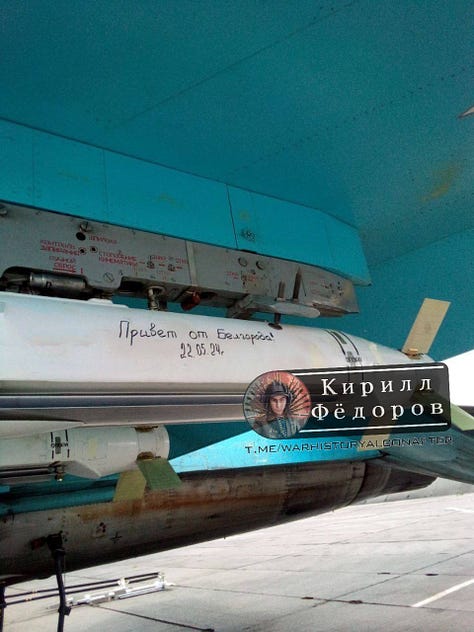

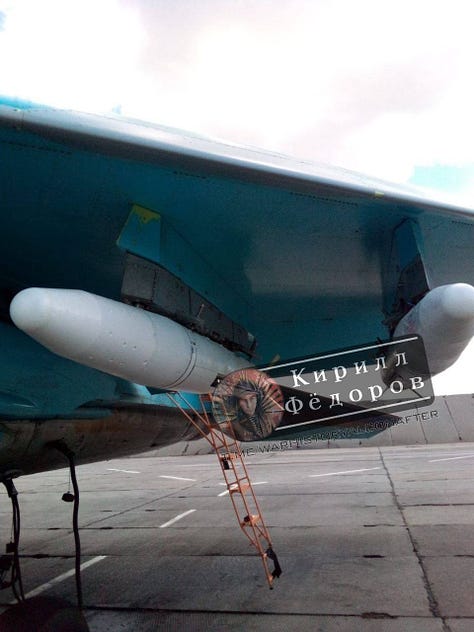
—
New articles press on about the failures of many Western systems:
Musk was forced to respond:
—
There is quite a bit more to be said, but this report is long enough so I think we’ll leave it to the next.
If you enjoyed the meaty update, don’t forget to reward your humbly hardworking author with a paid subscription and/or tip at: buymeacoffee.com/Simplicius
Your support is invaluable. If you enjoyed the read, I would greatly appreciate if you subscribed to a monthly/yearly pledge to support my work, so that I may continue providing you with detailed, incisive reports like this one.
Alternatively, you can tip here: buymeacoffee.com/Simplicius





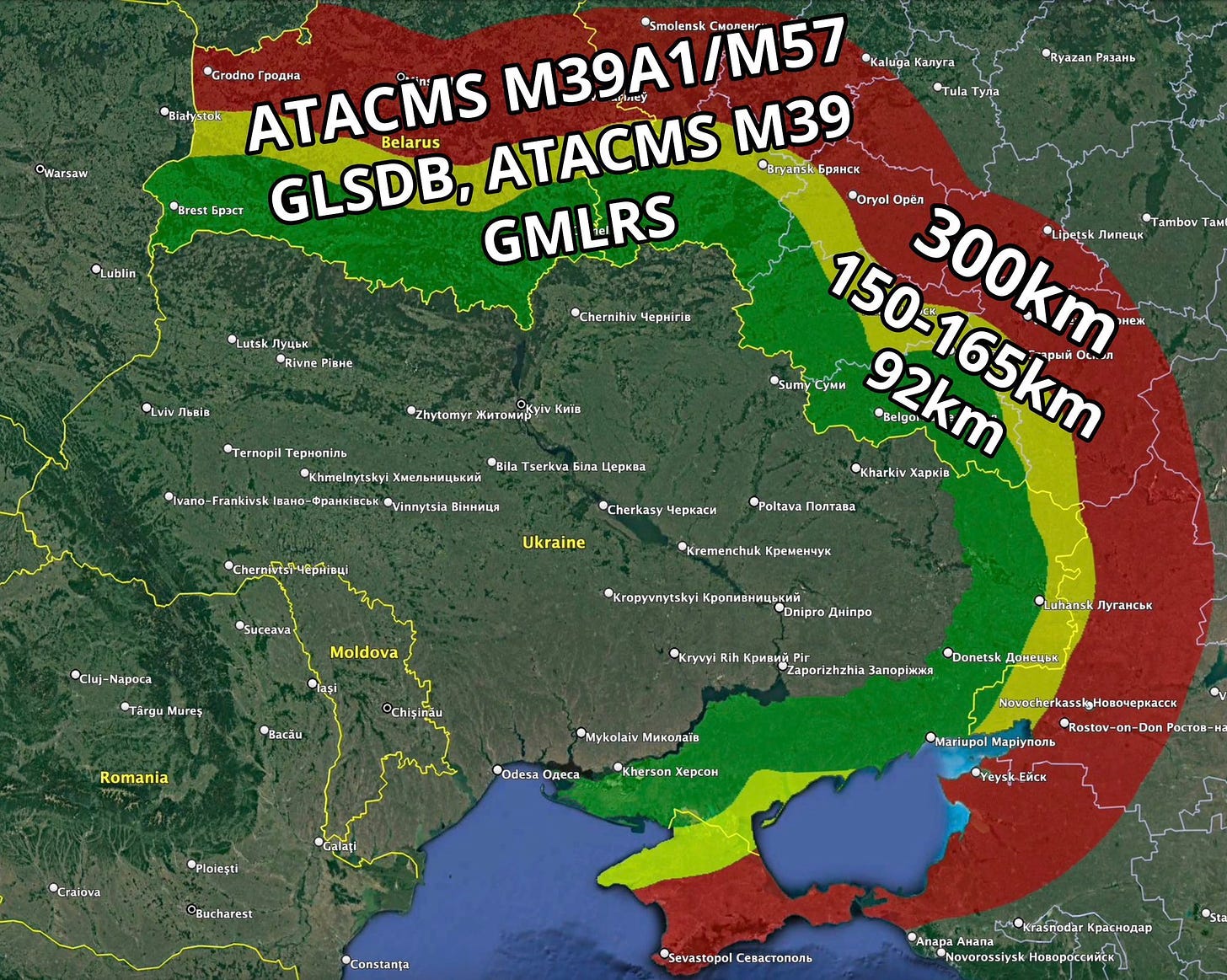

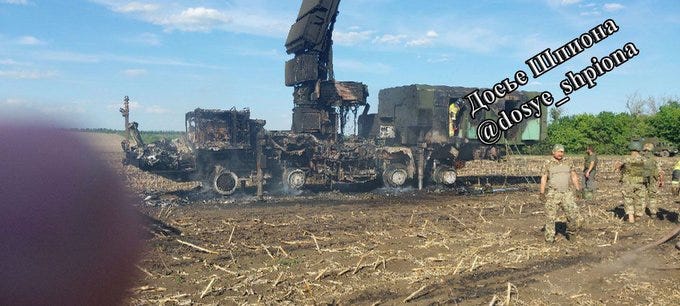

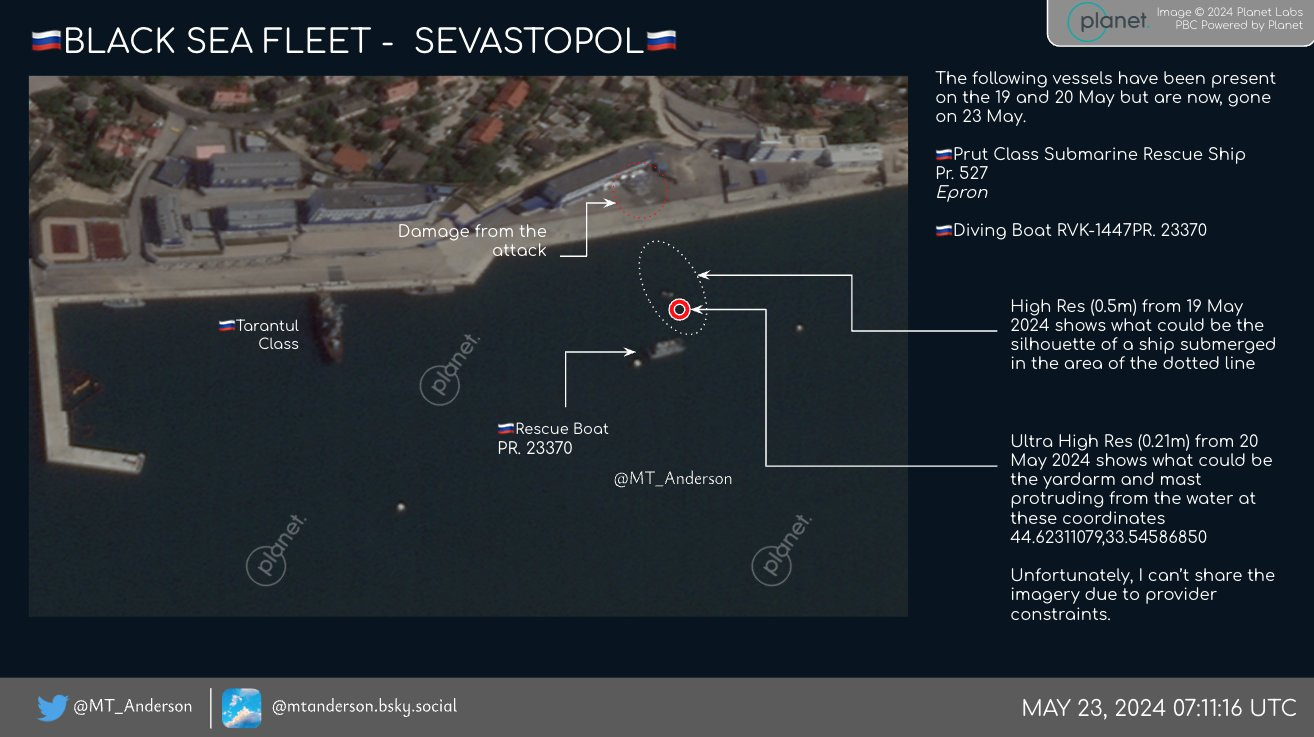
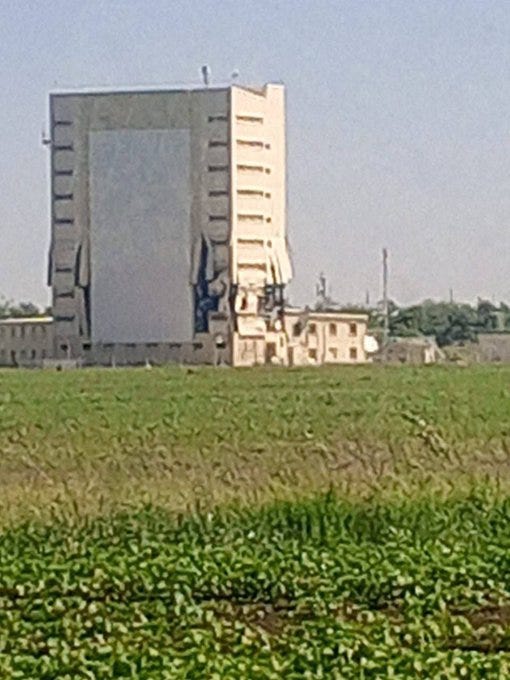
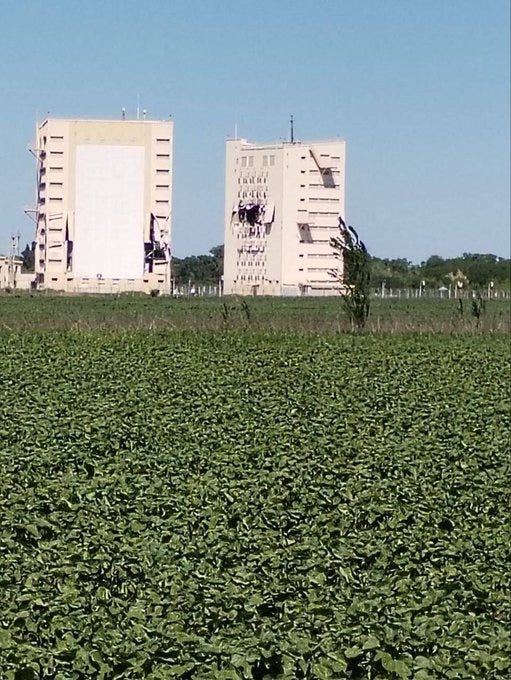

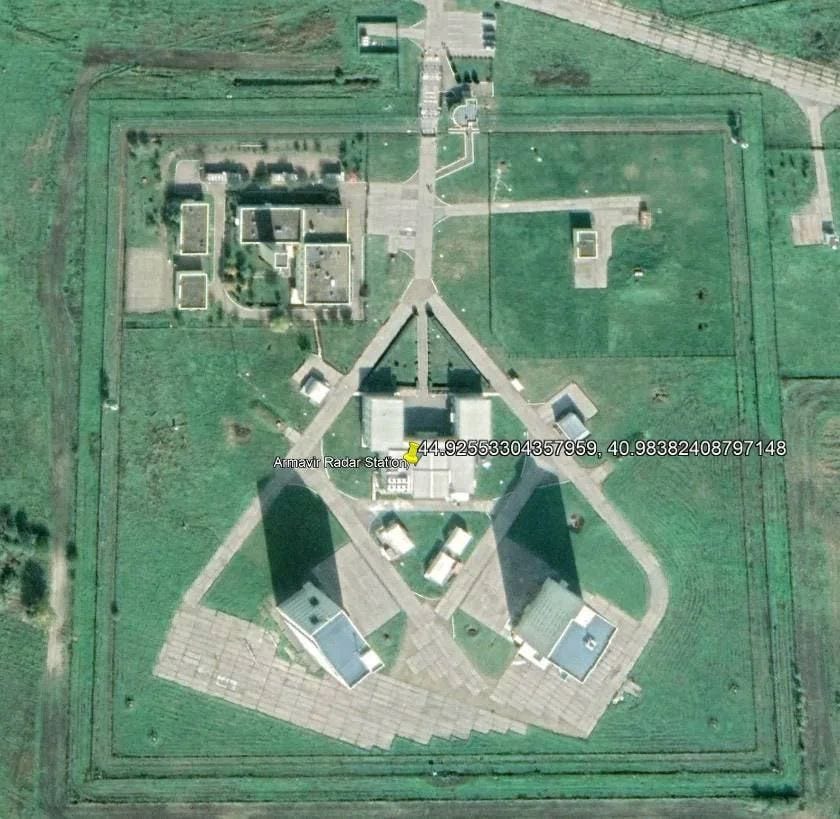


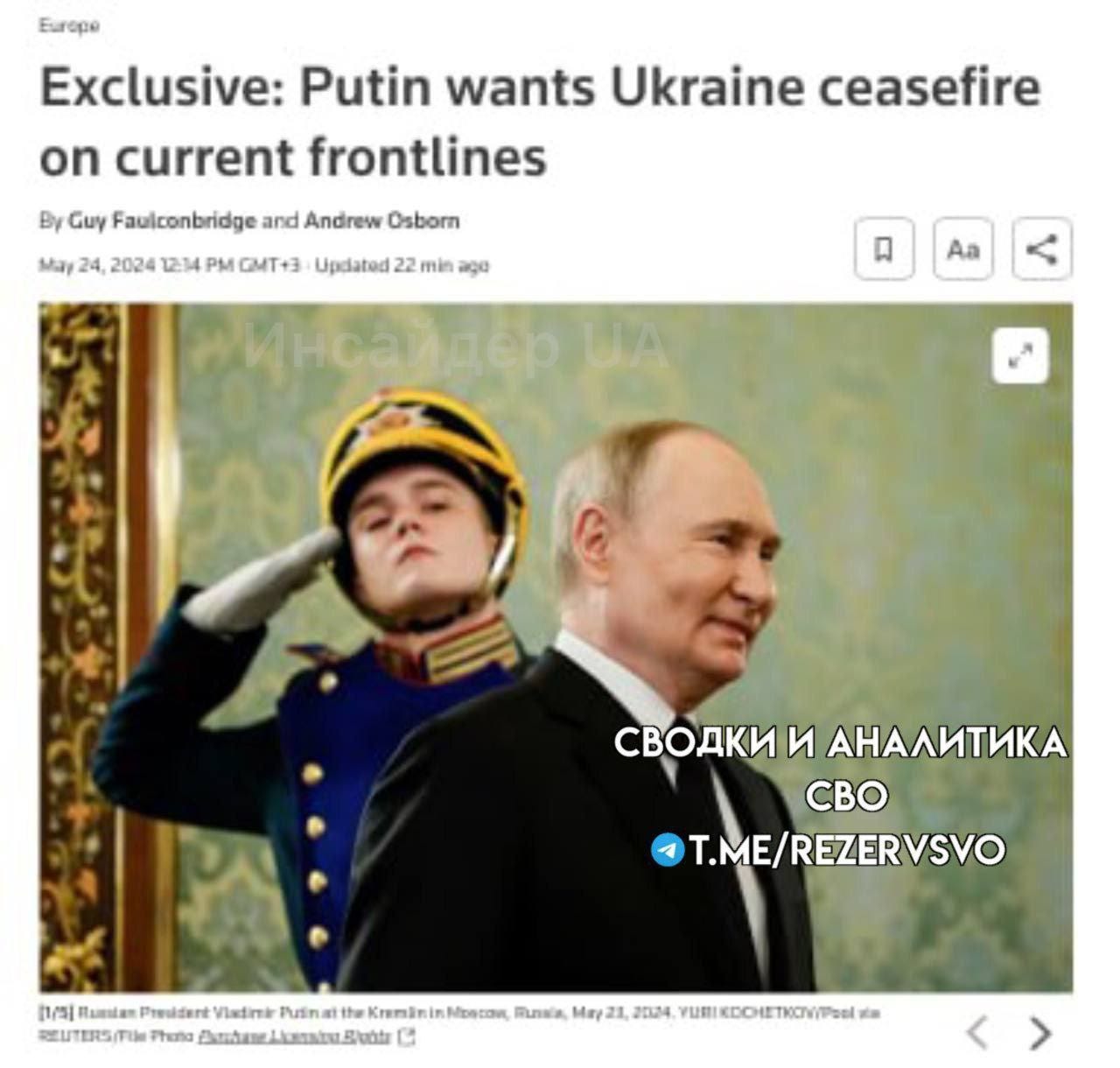
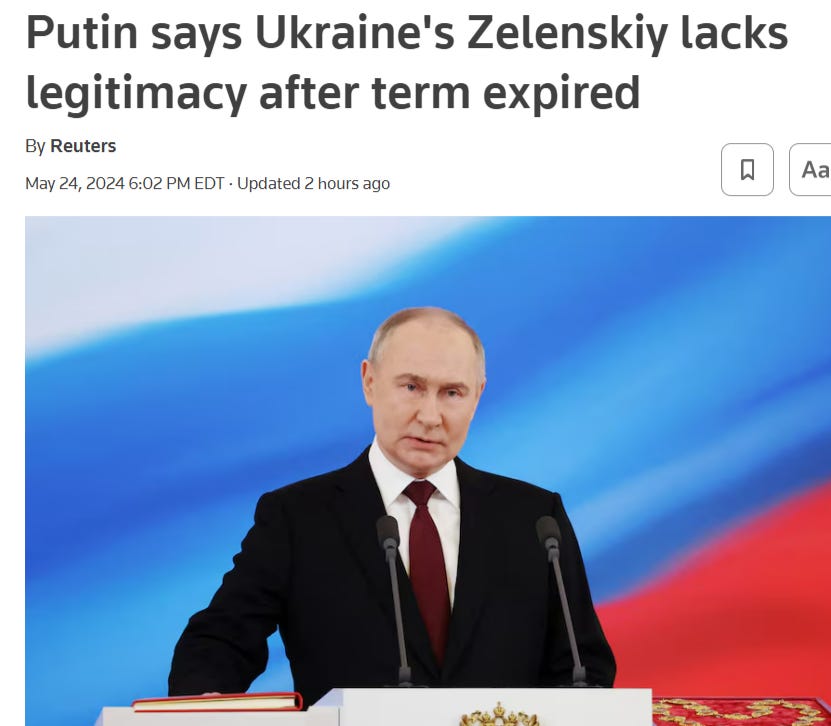


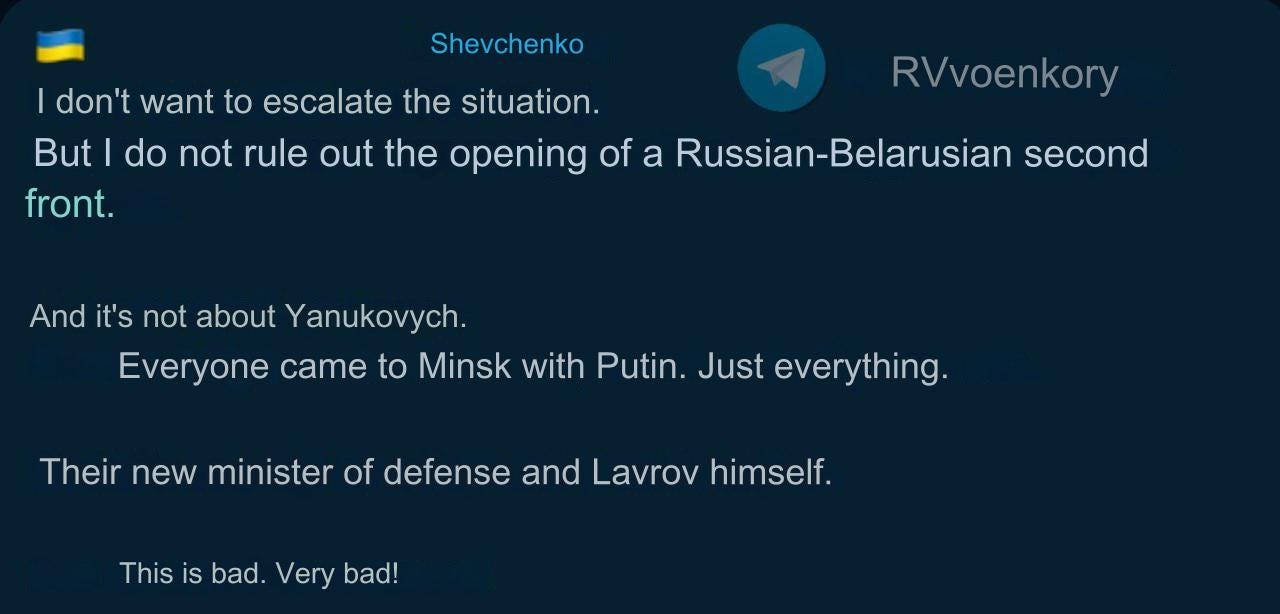
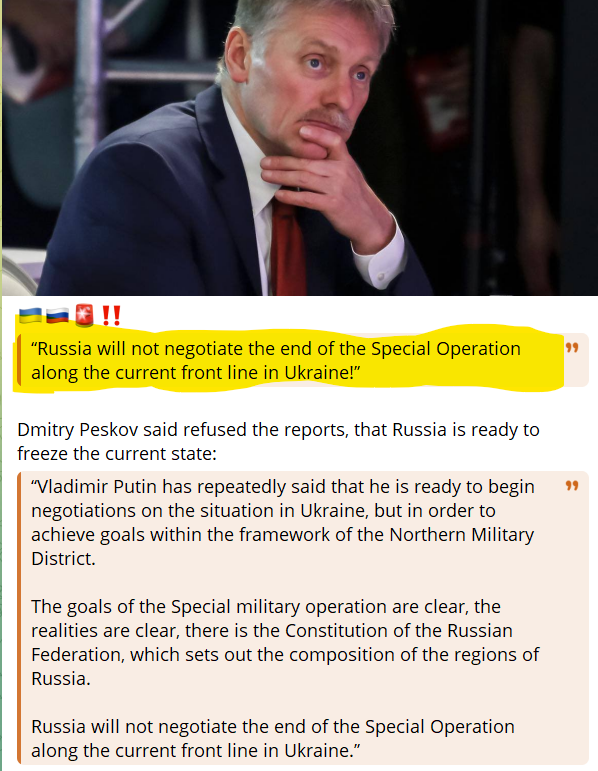
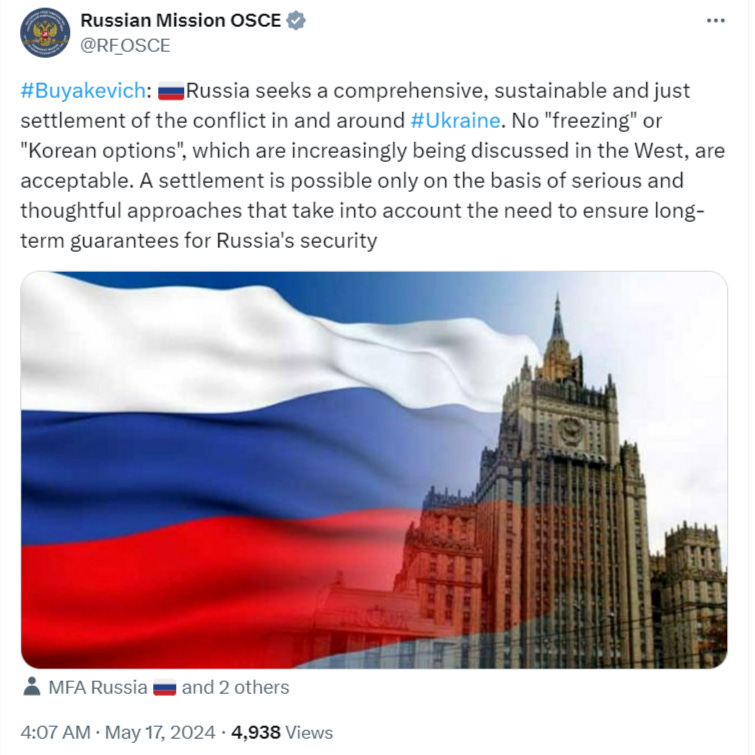
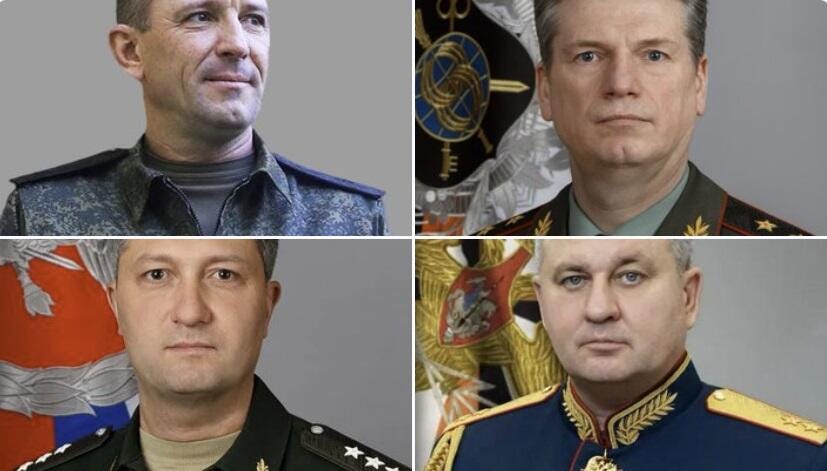
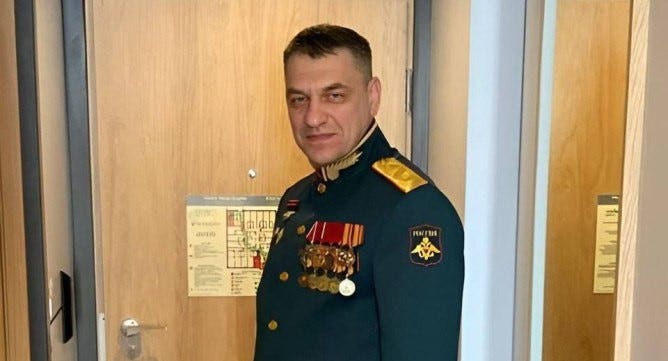
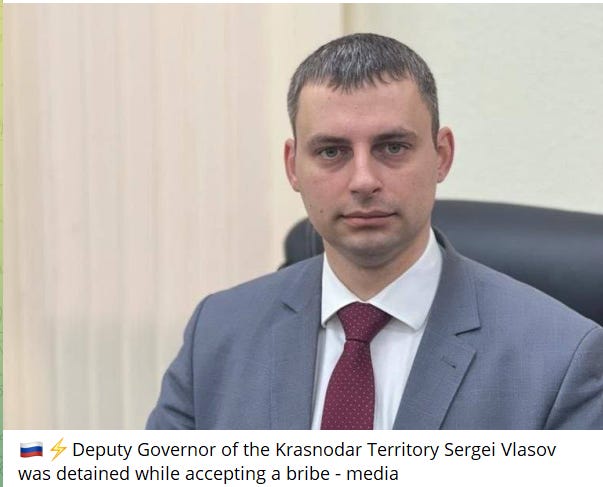
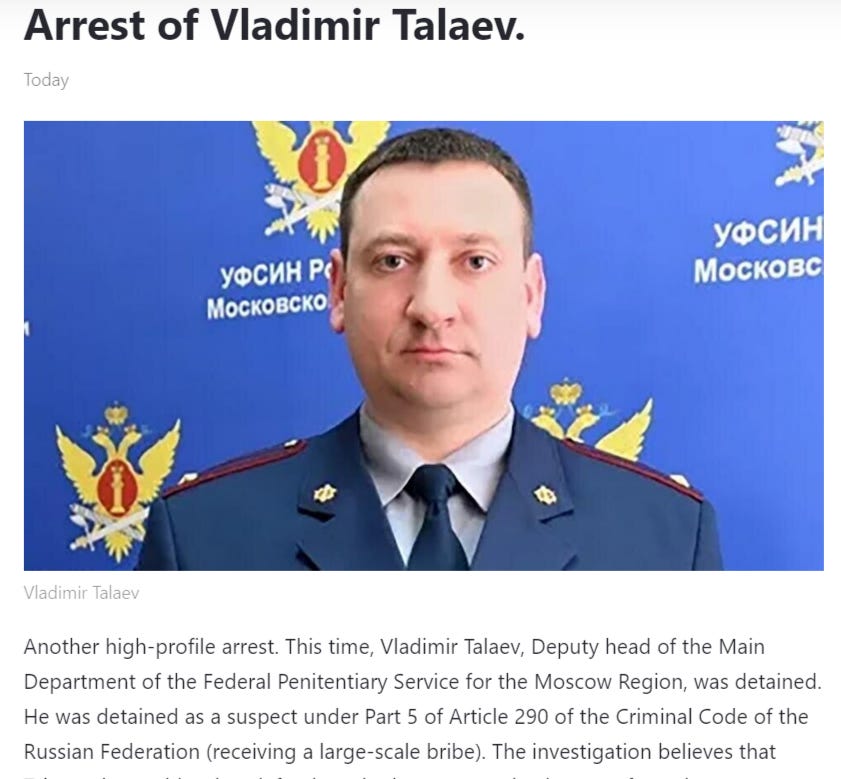
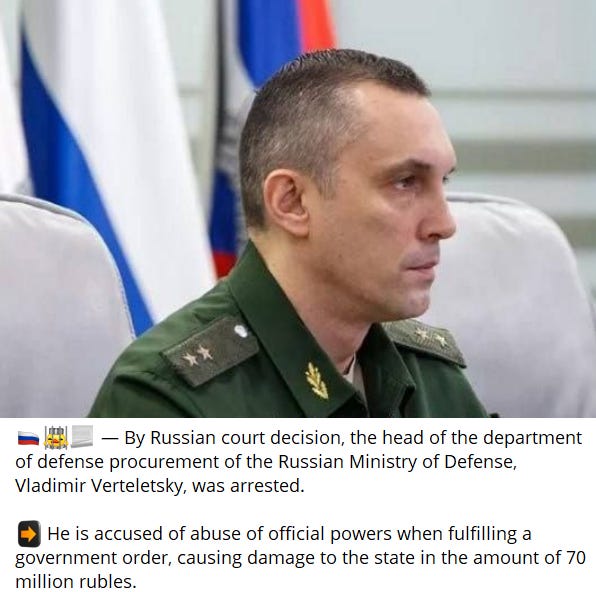
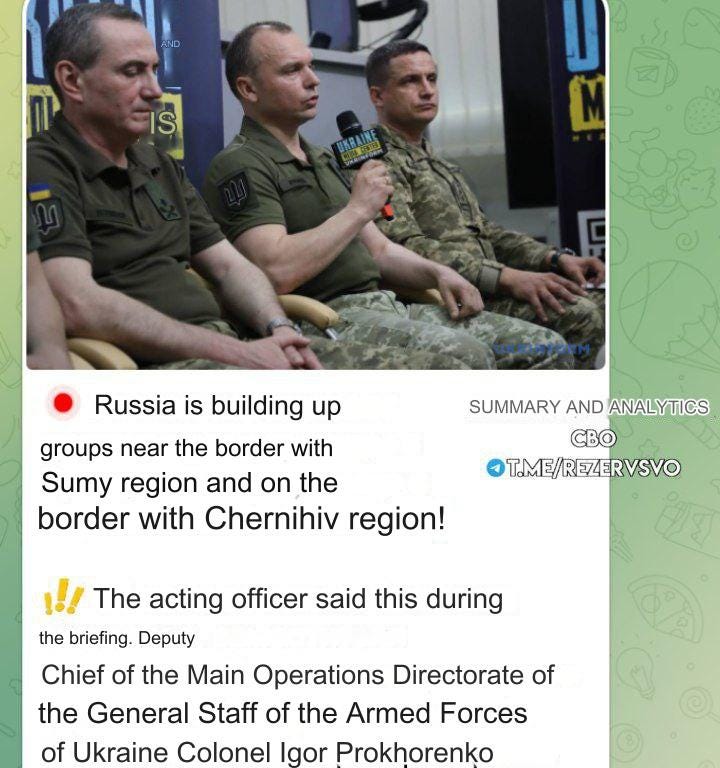
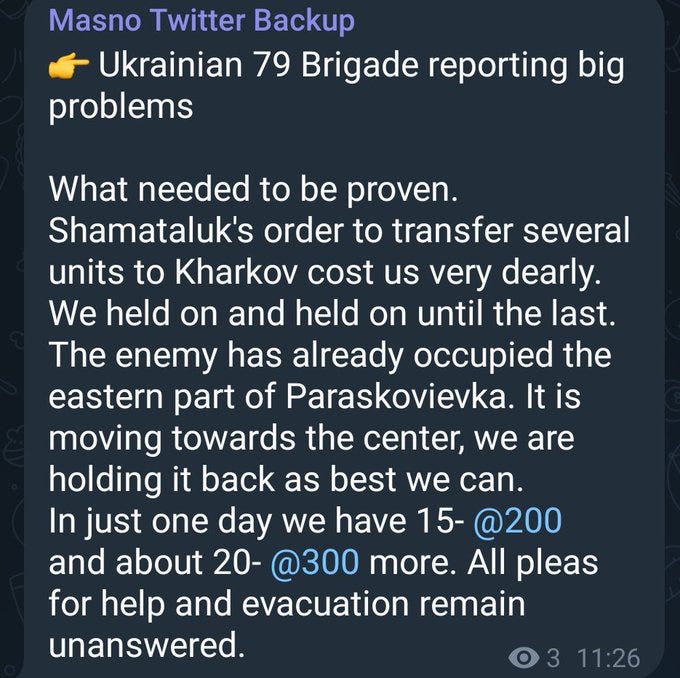
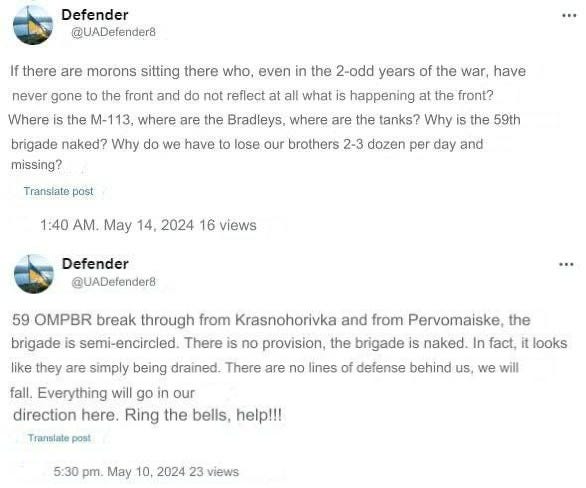
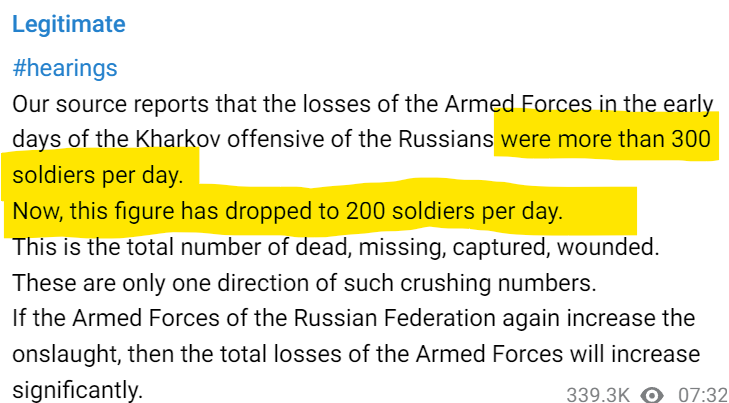


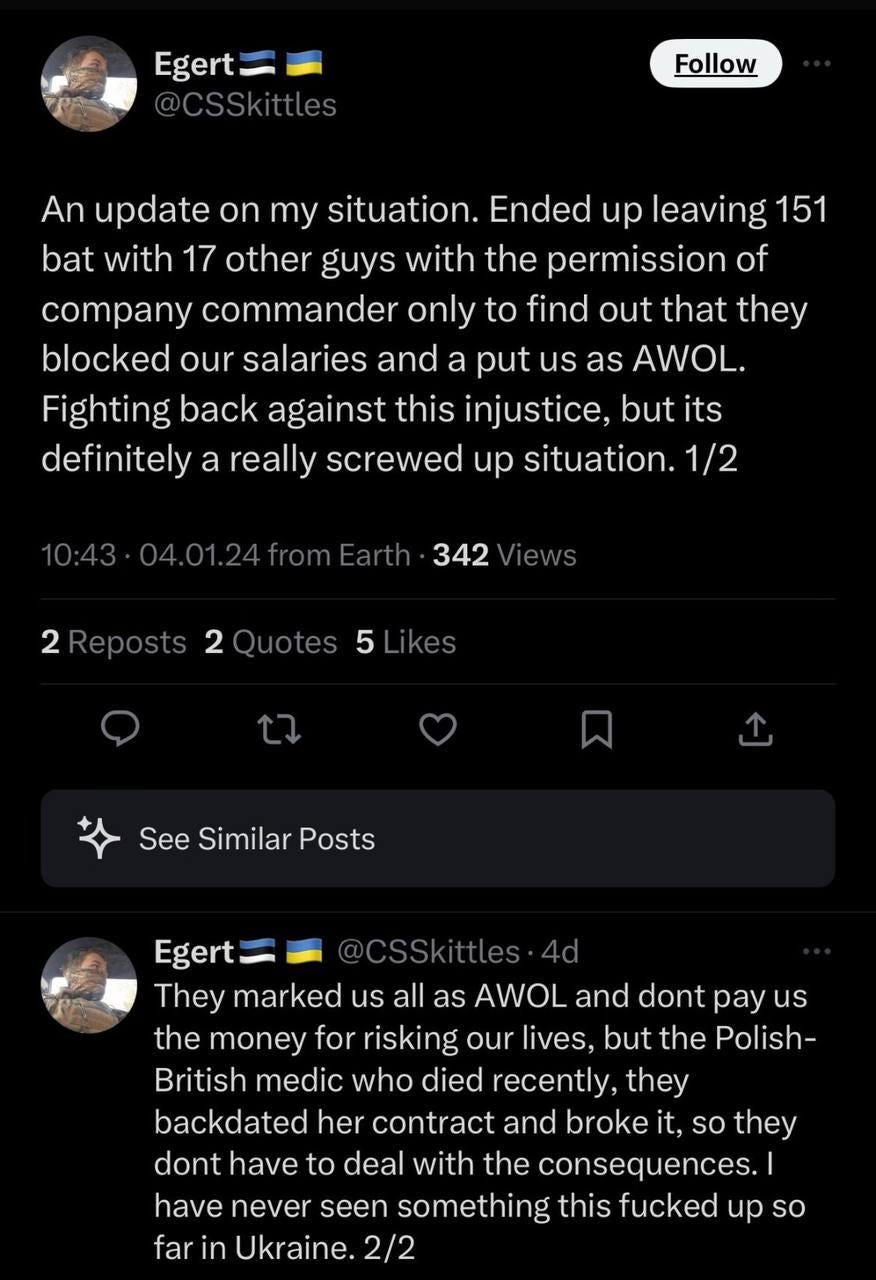


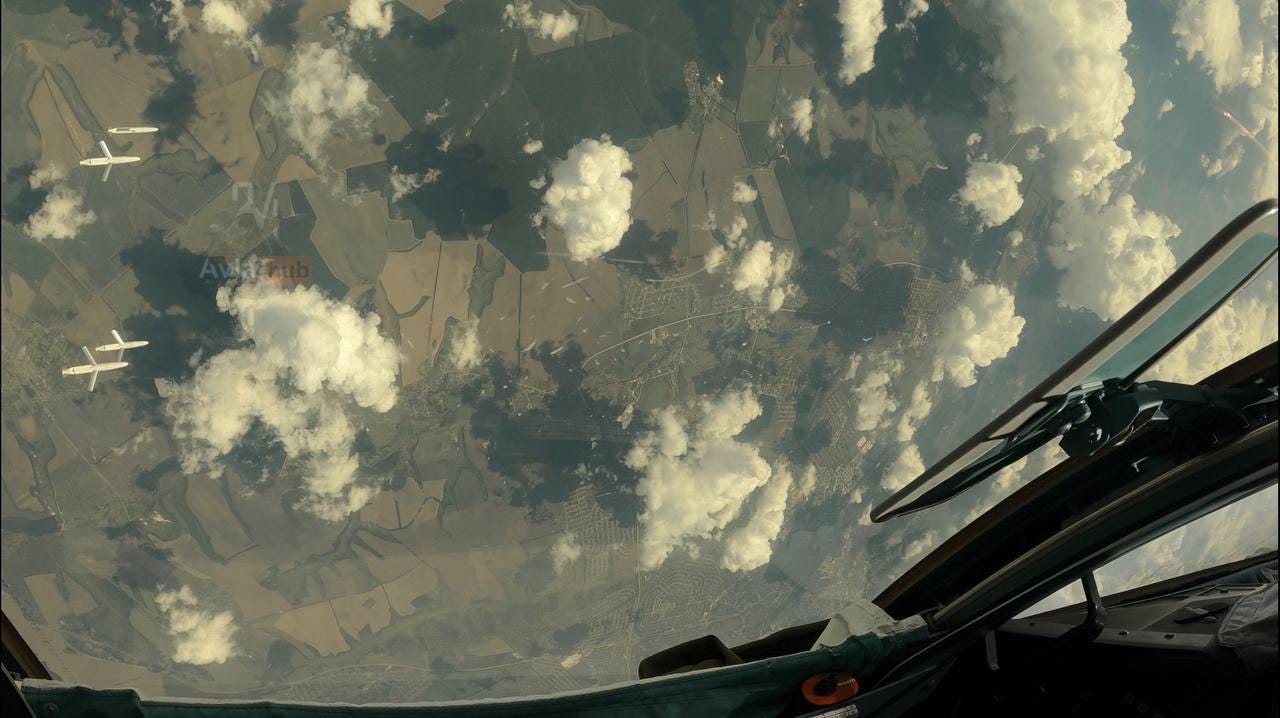
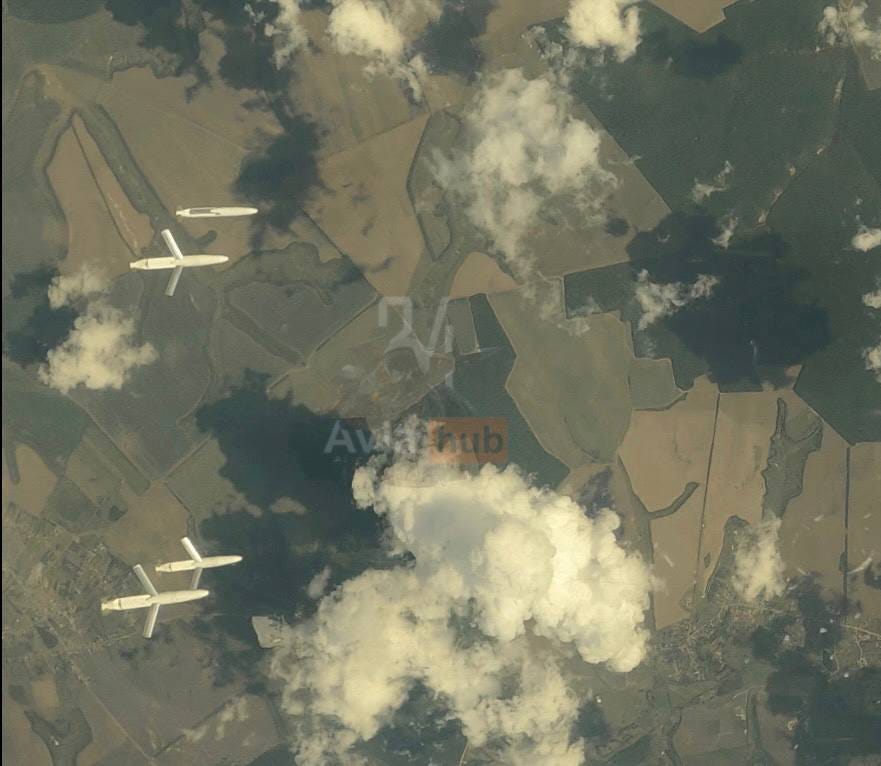
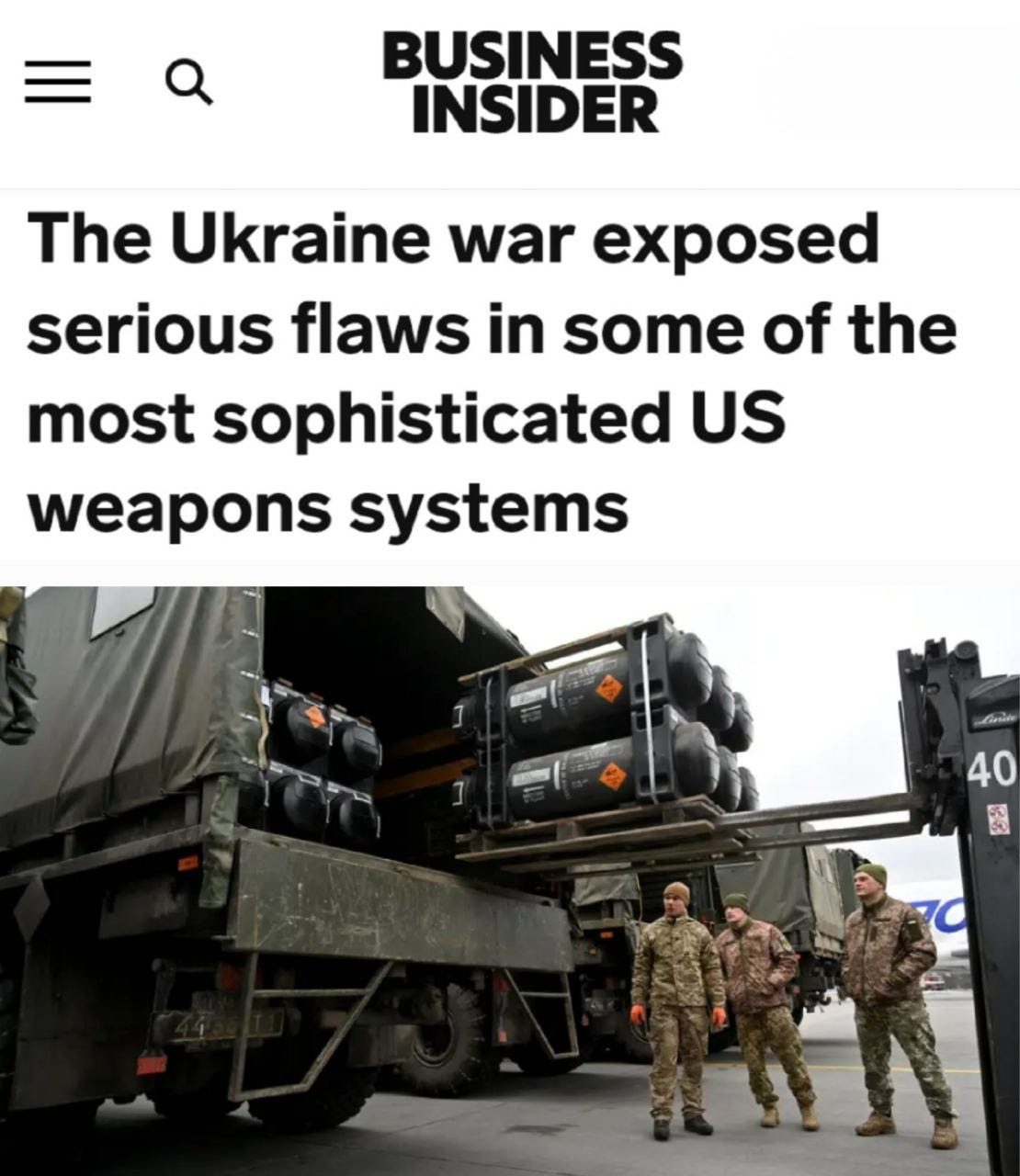

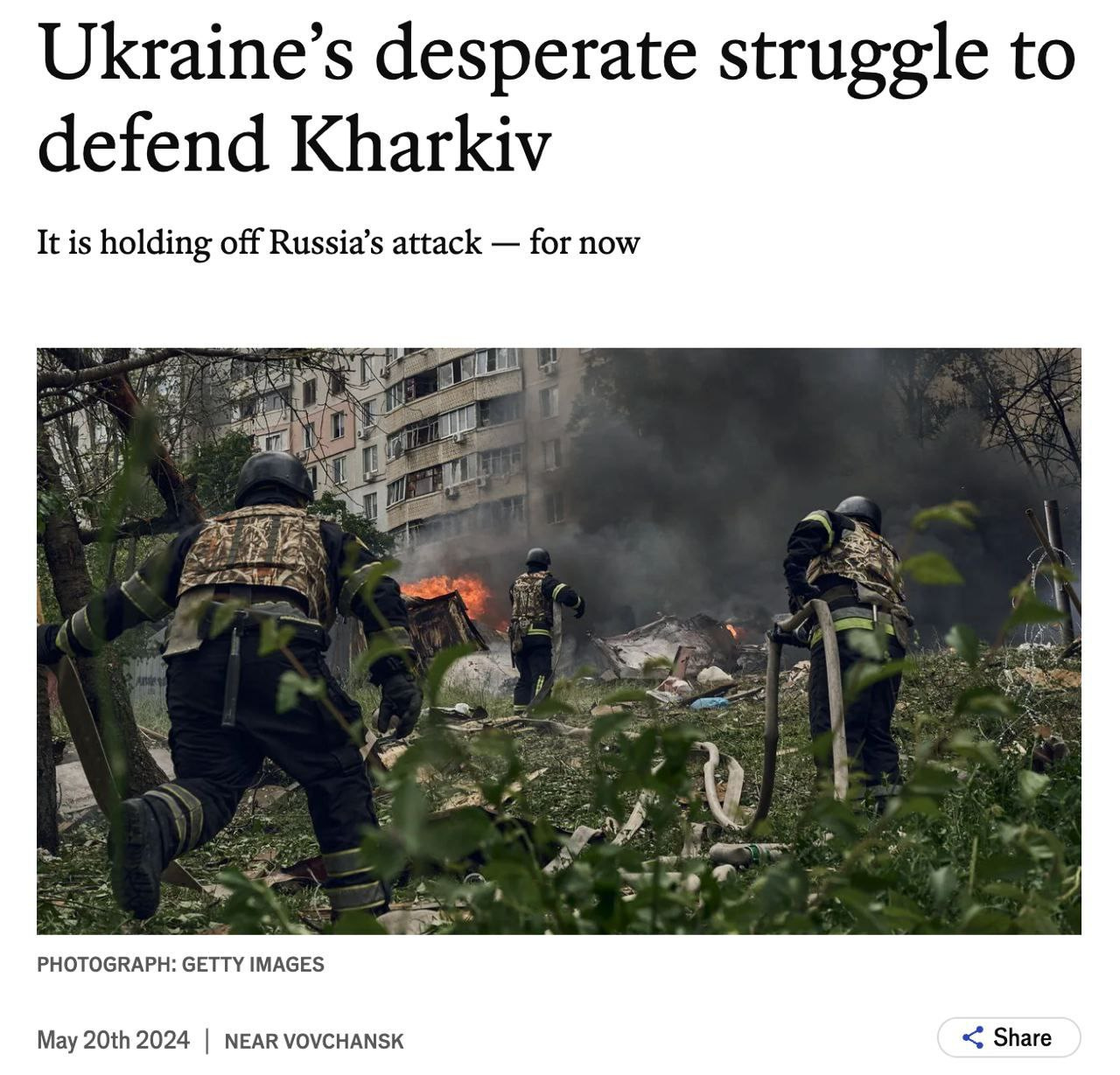
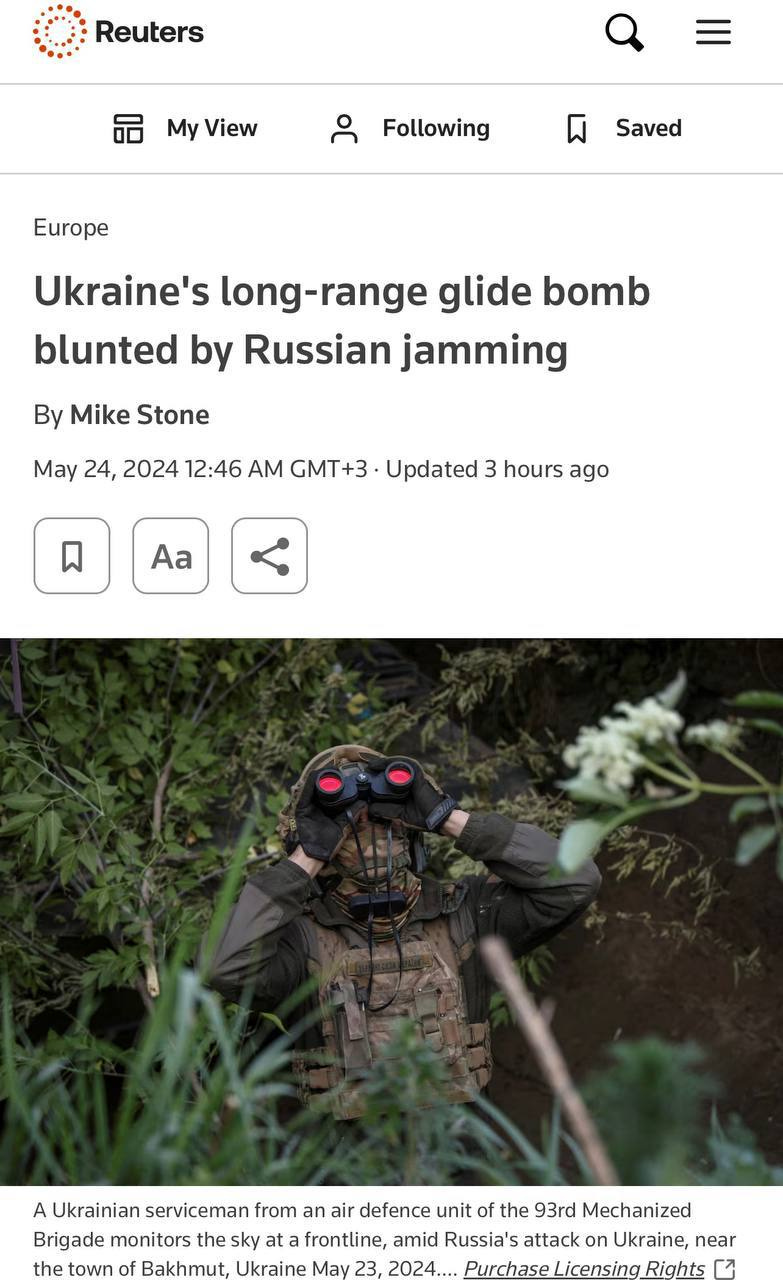
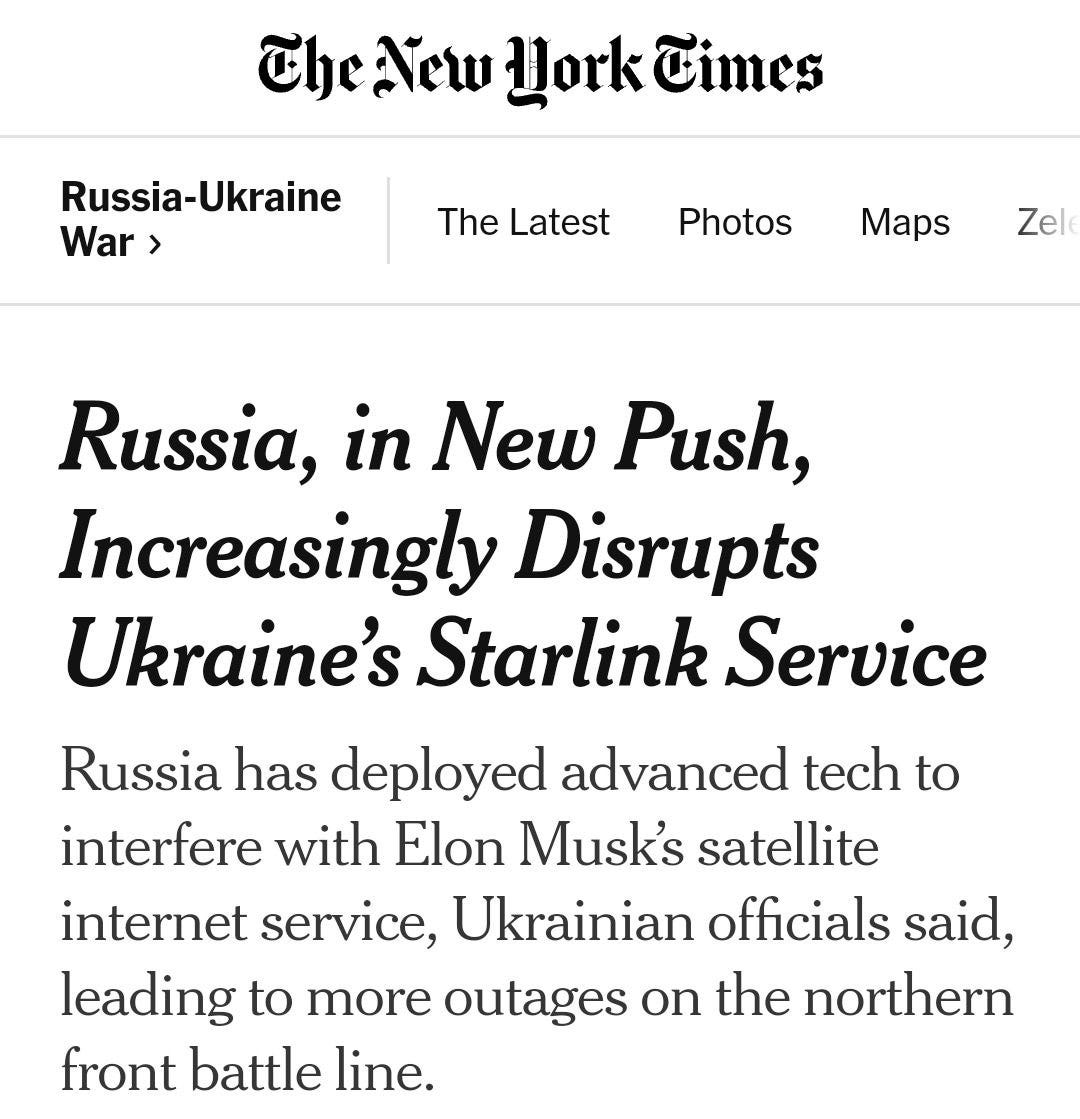
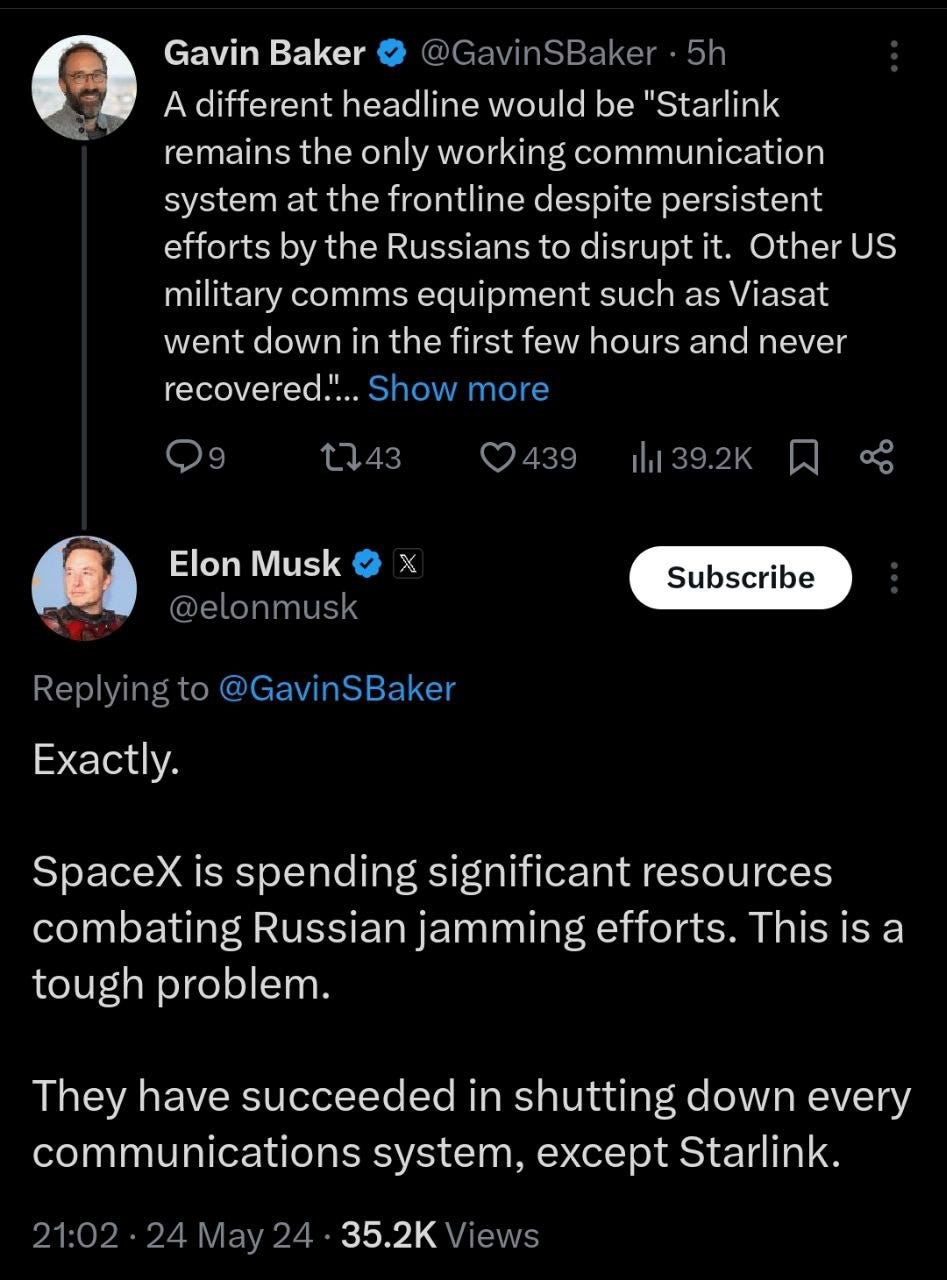
Thank you, Simplicius. A few points:
1. I would be more concerned if the Ukrainians/NATO had somehow caught the Russians off-guard with these provocations/escalations, but I doubt they have.
In fact, these attacks on Russian territory cannot be a huge surprise to Moscow. In my view, they are exactly what the Russians must have been expecting from Day 1. I am sure that Moscow fully expect the attacks to become even more reckless, too.
2. Ditto, given the evidence to date of excellent Russian human intelligence on the ground in Ukraine and outside it, I am confident that the Russians already have a pretty good idea of not just all NATO long range weapons systems in Ukraine, but how they are entering the country and where they are being stored.
3. The one variable worth considering is that NATO does not have an unlimited inventory of these weapons, and as your report accurately explains, they're using a lot of them to score the odd successful hit.
4. The other factor is that no AD system is infallible. Right now, in order to destroy an S350/400 with 1 missile, it seems that the same AD system accurately destroys many more. So yes - the loss of an AD system is unfortunate, but they're still very effective systems.
5. Ukraine is part of a much larger geopolitical conflict that is really stretching NATO and the collective West. There's the Middle East, of course. But also, I can't be the only one who has noticed how much more intense this new Chinese build up around Taiwan has become.
So what to make of all this?
- Consistent with their overall strategy to date, the Kremlin may have decided to accept some losses from long range strikes, in order to attrit/wear down the available NATO stocks. NATO simply doesn't have enough in the shed to keep the strikes going forever.
- Combined with this, Russia is advancing on all axes in Ukraine and this is going to make it even more difficult for NATO/Ukraine to conduct long range strikes. It already is.
- NATO (in particular the US) is in reality stretched almost to breaking point. All it takes is a major new front to open up, in particular Taiwan, and the situation becomes even more challenging. I don't have a crystal ball, but China may be building up to open that front as we speak.
End of day - while they will suffer the odd setback here an there, I remain confident that overall Russia is fully prepared for what is happening, and in fact always has been in fact (far more than NATO), and hence will prevail.
Unsurprisingly, missile defense is not absolute. Not patriots vs iskander/khinzal/zircon, not iron dome vs Iranians, and not s-300/400 vs atacms/storm shadow etc. Russia defeating Ukraine air defense is the reasons why the glide bombs have been so successful
Russia will need to continuously crank these systems out. Otherwise when the F16s show up they will be sending air launched cruise missiles to crimea regularly